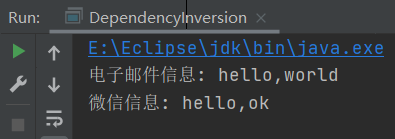жӮЁеҘҪпјҢзҷ»еҪ•еҗҺжүҚиғҪдёӢи®ўеҚ•е“ҰпјҒ
е°Ҹзј–з»ҷеӨ§е®¶еҲҶдә«дёҖдёӢJavaдёӯдҫқиө–еҖ’иҪ¬еҺҹеҲҷжҳҜд»Җд№ҲпјҢзӣёдҝЎеӨ§йғЁеҲҶдәәйғҪиҝҳдёҚжҖҺд№ҲдәҶи§ЈпјҢеӣ жӯӨеҲҶдә«иҝҷзҜҮж–Үз« з»ҷеӨ§е®¶еҸӮиҖғдёҖдёӢпјҢеёҢжңӣеӨ§е®¶йҳ…иҜ»е®ҢиҝҷзҜҮж–Үз« еҗҺеӨ§жңү收иҺ·пјҢдёӢйқўи®©жҲ‘们дёҖиө·еҺ»дәҶи§ЈдёҖдёӢеҗ§пјҒ
й«ҳеұӮжЁЎеқ—дёҚеә”иҜҘдҫқиө–дҪҺеұӮжЁЎеқ—пјҢдәҢиҖ…йғҪеә”иҜҘдҫқиө–е…¶жҠҪиұЎгҖӮ
жҠҪиұЎдёҚеә”иҜҘдҫқиө–з»ҶиҠӮпјҢз»ҶиҠӮеә”иҜҘдҫқиө–жҠҪиұЎгҖӮ
дҫқиө–еҖ’иҪ¬ (еҖ’зҪ®) зҡ„дёӯеҝғжҖқжғіжҳҜйқўеҗ‘жҺҘеҸЈзј–зЁӢгҖӮ
дҫқиө–еҖ’иҪ¬еҺҹеҲҷжҳҜеҹәдәҺиҝҷж ·зҡ„и®ҫи®ЎзҗҶеҝө:зӣёеҜ№дәҺз»ҶиҠӮзҡ„еӨҡеҸҳжҖ§пјҢжҠҪиұЎзҡ„дёңиҘҝиҰҒзЁіе®ҡзҡ„еӨҡгҖӮд»ҘжҠҪиұЎдёәеҹәзЎҖжҗӯе»әзҡ„жһ¶жһ„жҜ”д»Ҙз»ҶиҠӮдёәеҹәзЎҖзҡ„жһ¶жһ„иҰҒзЁіе®ҡзҡ„еӨҡгҖӮеңЁJavaдёӯпјҢжҠҪиұЎжҢҮзҡ„жҳҜжҺҘеҸЈжҲ–жҠҪиұЎзұ»пјҢз»ҶиҠӮе°ұжҳҜе…·дҪ“зҡ„е®һзҺ°зұ»гҖӮ
дҪҝз”ЁжҺҘеҸЈжҲ–жҠҪиұЎзұ»зҡ„зӣ®зҡ„жҳҜеҲ¶е®ҡеҘҪ规иҢғпјҢиҖҢдёҚж¶үеҸҠд»»дҪ•е…·дҪ“зҡ„ж“ҚдҪңпјҢжҠҠеұ•зҺ°з»ҶиҠӮзҡ„д»»еҠЎдәӨз»ҷ他们зҡ„е®һзҺ°зұ»еҺ»е®ҢжҲҗгҖӮ
package com.szh.principle.inversion;
/**
*
*/
class Email {
public String getInfo() {
return "з”өеӯҗйӮ®д»¶дҝЎжҒҜ: hello,world";
}
}
// е®ҢжҲҗPersonжҺҘ收ж¶ҲжҒҜзҡ„еҠҹиғҪ
// ж–№ејҸ1еҲҶжһҗ
// 1. з®ҖеҚ•пјҢжҜ”иҫғе®№жҳ“жғіеҲ°
// 2. еҰӮжһңжҲ‘们иҺ·еҸ–зҡ„еҜ№иұЎжҳҜ еҫ®дҝЎпјҢзҹӯдҝЎзӯүзӯүпјҢеҲҷж–°еўһзұ»пјҢеҗҢж—¶Personд№ҹиҰҒеўһеҠ зӣёеә”зҡ„жҺҘ收方法
// 3. и§ЈеҶіжҖқи·Ҝпјҡеј•е…ҘдёҖдёӘжҠҪиұЎзҡ„жҺҘеҸЈIReceiver, иЎЁзӨәжҺҘ收иҖ…, иҝҷж ·Personзұ»дёҺжҺҘеҸЈIReceiverеҸ‘з”ҹдҫқиө–
// еӣ дёәEmail, WeiXin зӯүзӯүеұһдәҺжҺҘ收зҡ„иҢғеӣҙпјҢ他们еҗ„иҮӘе®һзҺ°IReceiver жҺҘеҸЈе°ұok, иҝҷж ·жҲ‘们е°ұз¬ҰеҸ·дҫқиө–еҖ’иҪ¬еҺҹеҲҷ
class Person {
public void receive(Email email ) {
System.out.println(email.getInfo());
}
}
public class DependencyInversion {
public static void main(String[] args) {
Person person = new Person();
person.receive(new Email());
}
}
жҲ‘们еҸҜд»Ҙж №жҚ®дҫқиө–еҖ’иҪ¬еҺҹеҲҷеҜ№дёҠйқўзҡ„д»Јз ҒеҒҡдёҖдёӘж”№иҝӣпјҢеҰӮдёӢпјҡ????????????
package com.szh.principle.inversion.improve;
/**
*
*/
//е®ҡд№үжҺҘеҸЈ
interface IReceiver {
public String getInfo();
}
class Email implements IReceiver {
public String getInfo() {
return "з”өеӯҗйӮ®д»¶дҝЎжҒҜ: hello,world";
}
}
//еўһеҠ еҫ®дҝЎ
class WeiXin implements IReceiver {
public String getInfo() {
return "еҫ®дҝЎдҝЎжҒҜ: hello,ok";
}
}
//ж–№ејҸ2
class Person {
//иҝҷйҮҢжҲ‘们жҳҜеҜ№жҺҘеҸЈзҡ„дҫқиө–
public void receive(IReceiver receiver ) {
System.out.println(receiver.getInfo());
}
}
public class DependencyInversion {
public static void main(String[] args) {
//е®ўжҲ·з«Ҝж— йңҖж”№еҸҳ
Person person = new Person();
person.receive(new Email());
person.receive(new WeiXin());
}
}
package com.szh.principle.inversion.improve;
/**
* ж–№ејҸ1: йҖҡиҝҮжҺҘеҸЈдј йҖ’е®һзҺ°дҫқиө–
*/
interface IOpenAndClose1 {
public void open(ITV1 tv); //жҠҪиұЎж–№жі•,жҺҘ收жҺҘеҸЈ
}
interface ITV1 { //ITVжҺҘеҸЈ
public void play();
}
class OpenAndClose1 implements IOpenAndClose1 {
@Override
public void open(ITV1 tv){
tv.play();
}
}
class ChangHong1 implements ITV1 {
@Override
public void play() {
System.out.println("й•ҝиҷ№з”өи§ҶжңәпјҢжү“ејҖ");
}
}
public class DependencyPass1 {
public static void main(String[] args) {
ChangHong1 changHong = new ChangHong1();
OpenAndClose1 openAndClose = new OpenAndClose1();
openAndClose.open(changHong);
}
}
package com.szh.principle.inversion.improve;
/**
* ж–№ејҸ2: йҖҡиҝҮжһ„йҖ ж–№жі•дҫқиө–дј йҖ’
*/
interface IOpenAndClose2 {
public void open(); //жҠҪиұЎж–№жі•
}
interface ITV2 { //ITVжҺҘеҸЈ
public void play();
}
class OpenAndClose2 implements IOpenAndClose2 {
public ITV2 tv; //жҲҗе‘ҳ
public OpenAndClose2(ITV2 tv){ //жһ„йҖ еҷЁ
this.tv = tv;
}
public void open(){
this.tv.play();
}
}
class ChangHong2 implements ITV2 {
public void play() {
System.out.println("й•ҝиҷ№з”өи§ҶжңәпјҢжү“ејҖ");
}
}
public class DependencyPass2 {
public static void main(String[] args) {
ChangHong2 changHong = new ChangHong2();
//йҖҡиҝҮжһ„йҖ еҷЁиҝӣиЎҢдҫқиө–дј йҖ’
OpenAndClose2 openAndClose = new OpenAndClose2(changHong);
openAndClose.open();
}
}
package com.szh.principle.inversion.improve;
/**
* ж–№ејҸ3: йҖҡиҝҮsetterж–№жі•дј йҖ’
*/
interface IOpenAndClose3 {
public void open(); // жҠҪиұЎж–№жі•
public void setTv(ITV3 tv);
}
interface ITV3 { // ITVжҺҘеҸЈ
public void play();
}
class OpenAndClose3 implements IOpenAndClose3 {
private ITV3 tv;
public void setTv(ITV3 tv) {
this.tv = tv;
}
public void open() {
this.tv.play();
}
}
class ChangHong3 implements ITV3 {
public void play() {
System.out.println("й•ҝиҷ№з”өи§ҶжңәпјҢжү“ејҖ");
}
}
public class DependencyPass3 {
public static void main(String[] args) {
ChangHong3 changHong = new ChangHong3();
//йҖҡиҝҮsetterж–№жі•иҝӣиЎҢдҫқиө–дј йҖ’
OpenAndClose3 openAndClose = new OpenAndClose3();
openAndClose.setTv(changHong);
openAndClose.open();
}
}
дҪҺеұӮжЁЎеқ—е°ҪйҮҸйғҪиҰҒжңүжҠҪиұЎзұ»жҲ–жҺҘеҸЈпјҢжҲ–иҖ…дёӨиҖ…йғҪжңүпјҢзЁӢеәҸзЁіе®ҡжҖ§жӣҙеҘҪгҖӮ
еҸҳйҮҸзҡ„еЈ°жҳҺзұ»еһӢе°ҪйҮҸжҳҜжҠҪиұЎзұ»жҲ–жҺҘеҸЈпјҢиҝҷж ·жҲ‘们зҡ„еҸҳйҮҸеј•з”Ёе’Ңе®һйҷ…еҜ№иұЎй—ҙпјҢе°ұеӯҳеңЁдёҖдёӘзј“еҶІеұӮпјҢеҲ©дәҺзЁӢеәҸжү©еұ•е’ҢдјҳеҢ–гҖӮ
继жүҝж—¶йҒөеҫӘйҮҢж°ҸжӣҝжҚўеҺҹеҲҷгҖӮпјҲжҲ‘们еҗҺйқўеҶҚиҜҙпјү
д»ҘдёҠжҳҜвҖңJavaдёӯдҫқиө–еҖ’иҪ¬еҺҹеҲҷжҳҜд»Җд№ҲвҖқиҝҷзҜҮж–Үз« зҡ„жүҖжңүеҶ…е®№пјҢж„ҹи°ўеҗ„дҪҚзҡ„йҳ…иҜ»пјҒзӣёдҝЎеӨ§е®¶йғҪжңүдәҶдёҖе®ҡзҡ„дәҶи§ЈпјҢеёҢжңӣеҲҶдә«зҡ„еҶ…е®№еҜ№еӨ§е®¶жңүжүҖеё®еҠ©пјҢеҰӮжһңиҝҳжғіеӯҰд№ жӣҙеӨҡзҹҘиҜҶпјҢж¬ўиҝҺе…іжіЁдәҝйҖҹдә‘иЎҢдёҡиө„и®Ҝйў‘йҒ“пјҒ
е…ҚиҙЈеЈ°жҳҺпјҡжң¬з«ҷеҸ‘еёғзҡ„еҶ…е®№пјҲеӣҫзүҮгҖҒи§Ҷйў‘е’Ңж–Үеӯ—пјүд»ҘеҺҹеҲӣгҖҒиҪ¬иҪҪе’ҢеҲҶдә«дёәдё»пјҢж–Үз« и§ӮзӮ№дёҚд»ЈиЎЁжң¬зҪ‘з«ҷз«ӢеңәпјҢеҰӮжһңж¶үеҸҠдҫөжқғиҜ·иҒ”зі»з«ҷй•ҝйӮ®з®ұпјҡis@yisu.comиҝӣиЎҢдёҫжҠҘпјҢ并жҸҗдҫӣзӣёе…іиҜҒжҚ®пјҢдёҖз»ҸжҹҘе®һпјҢе°Ҷз«ӢеҲ»еҲ йҷӨж¶үе«ҢдҫөжқғеҶ…е®№гҖӮ
жӮЁеҘҪпјҢзҷ»еҪ•еҗҺжүҚиғҪдёӢи®ўеҚ•е“ҰпјҒ